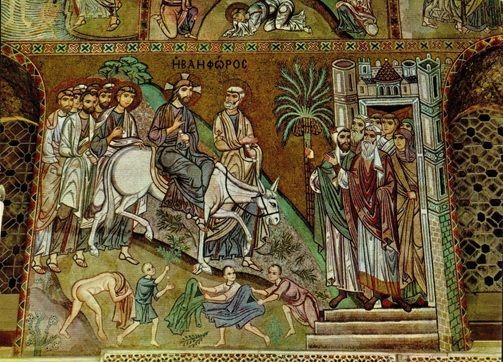Meditácia na palmovú nedeľu s Veľkým reverendom Kevinom Francisom Donlonom, ECLJ , anglickým pomocným biskupom Zanzibarskej diecézy.
MEDITAZIONE PER LA DOMENICA DELLE PALME DEL MOLTO REV.DO KEVIN FRANCIS DONLON, ECLJ, VESCOVO AUSILIARE ANGLICANO DELLA DIOCESI DI ZANZIBAR
(Ingresso di Gesù a Gerusalemme, Palazzo Reale, Cappella Palatina, Palermo, sec. XII)
Carissimi Confratelli e Consorelle dell’Ordine Militare ed Ospedaliero di San Lazzaro di Gerusalemme,
la Domenica delle Palme è il giorno in cui si celebra l’ingresso trionfale e pacifico di Gesù a Gerusalemme. L’intera sequenza dell’ingresso di Gesù secondo i Vangeli ha molti aspetti importanti che coinvolgono la partecipazione di Gesù, dei suoi discepoli e di coloro che assistono all’evento. L’importanza del racconto è sottolineata dal fatto che si trova in tutti e quattro i Vangeli. La celebrazione della Domenica delle Palme ha avuto origine nella Chiesa di Gerusalemme, intorno alla fine del IV secolo. La cerimonia iniziale della Domenica delle Palme consisteva in preghiere, inni e sermoni recitati dal clero mentre il popolo si recava a piedi nei vari luoghi sacri della città.
San Cirillo di Gerusalemme scrive della commemorazione annuale di questo grande evento, come riportato nelle Scritture, e l’usanza era osservata anche dai padri del deserto dell’Egitto e della Siria.
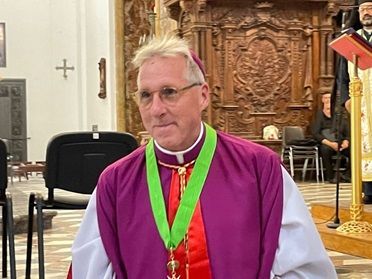
(Molto Reverendo Vescovo Kevin Francis Donlon, ECLJ)
Nel V secolo, la celebrazione della Domenica delle Palme si era diffusa fino a Costantinopoli. La prima testimonianza di una consuetudine liturgica risale al VI secolo, quando il Sacramentario di San Gregorio illustra le nuove tradizioni della Domenica delle Palme: la benedizione rituale delle palme e la processione mattutina al posto di quella serale, che nell’VIII secolo prende il nome di „Dominica in Palmis“ o „Domenica delle Palme“. Nei Paesi in cui non si trovano palme, si usano rami di tasso, salice e salicornia. Nella tradizione orientale, durante la liturgia, viene esposta l’icona festosa di Cristo che cavalca un asino verso Gerusalemme mentre il popolo agita rami di palma. È interessante notare che nella tradizione della Chiesa orientale la Settimana Santa inizia tecnicamente il giorno di San Lazzaro, il giorno prima della Domenica delle Palme, che è in realtà il primo giorno della Settimana Santa (non la Domenica delle Palme come nella Chiesa occidentale).
Gli asini, nonostante il loro utilizzo come animali da lavoro, sono raramente ritratti in una luce positiva. Anche l’Ih-Oh di Milne, nel classico racconto per bambini Winnie the Pooh, ha problemi di immagine. Spesso questi animali sono visti come muti, testardi o stupidi, per non dire poco attraenti. Il povero Ih-Oh riflette sulla sua esistenza pensando al fatto che le sue orecchie sono troppo lunghe e goffe e i suoi piedi troppo corti. Con un’immagine così povera c’è da chiedersi… È questo il modo di viaggiare di un re?
Dio, nella sua saggezza, sceglie per Gesù l’animale più basso per entrare nella pienezza del suo ruolo, non diversamente dall’asino su cui Maria cavalcò per consegnare Gesù a Betlemme. È interessante notare come l’evangelista descriva questa situazione con l’animale di bassa statura…“. Il Signore ha bisogno di lui“. L’asino insignificante e il suo puledro hanno svolto il ruolo assegnato nel trasportare Cristo sia per la sua nascita che per la sua morte nella crocifissione. Nessuna delle due cose sarebbe stata possibile senza il ruolo dell’asino e del puledro. Questa piccola immagine serve a ricordare che Dio prende gli ultimi per l’opera del suo Regno. I proprietari non sapevano che il loro atto di sottomissione e obbedienza alle esigenze di Gesù avrebbe portato a un evento così glorioso: l’ingresso trionfale descritto nei versetti.
Poiché la Domenica delle Palme segna l’inizio della Settimana Santa e del viaggio di Gesù verso Gerusalemme, dobbiamo porci la domanda: Come percorreremo questa Settimana? Siamo in grado di affrontare il viaggio con umiltà? Possiamo camminare con semplicità? Possiamo sforzarci di trascendere gli aspetti frenetici e, a volte, pesanti della vita, appesantiti da cose che non sono il senso del viaggio dell’anima? Abbiamo il coraggio di non limitarci ad acclamare Gesù con degli osanna, ma di camminare con lui ad ogni passo? Rinnoviamo il nostro proposito, in questa Domenica delle Palme, di prendere l’impegno dell’amore kenotico e di fare il viaggio verso Gerusalemme con Nostro Signore.
Preghiamo… Dio onnipotente ed eterno, hai scelto di dare all’umanità un modello di umiltà: il nostro Salvatore ha assunto la nostra carne e si è sottoposto alla croce. Concedici la grazia di conservare fedelmente gli insegnamenti che ci ha dato nella sua Passione e di partecipare alla sua risurrezione. Questo ti chiediamo per il nostro Signore Gesù Cristo, tuo Figlio.
+ Kevin Francis Donlon, ECLJ,
Vescovo Ausiliare Anglicano della Diocesi di Zanzibar
MEDITATION FOR PALM SUNDAY BY THE RIGHT REVEREND KEVIN FRANCIS DONLON, ECLJ, ANGLICAN ASSISTANT BISHOP OF THE DIOCESE OF ZANZIBAR
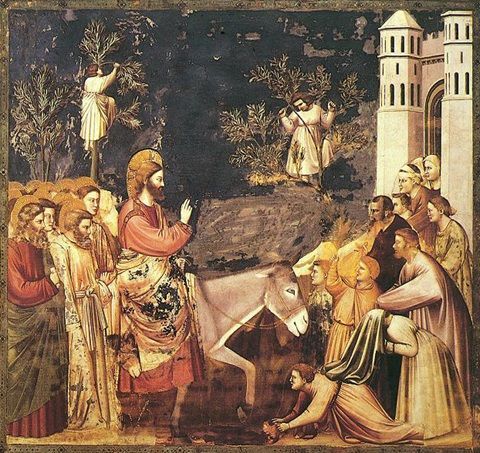
(Giotto di Bondone, Entrance to Jerusalem, Scrovegni Chapel in Padua, sec. XIV)
Dear Confreres and Sisters of the Military and Hospitaller Order of St Lazarus of Jerusalem,
Palm Sunday is the day we celebrate Jesus’ triumphal and peaceful entrance into Jerusalem. The entire entrance sequence by Jesus according to the gospels has many important aspects that involve the participation of Jesus, his disciples, and those witnessing the event. The significance of the story is underlined by the fact that it is found in all four Gospels. The celebration of Palm Sunday originated in Jerusalem Church, around the late fourth century. The early Palm Sunday ceremony consisted of prayers, hymns, and sermons recited by the clergy while the people walked to various holy sites throughout the city.
St. Cyril of Jerusalem writes about annual commemoration of this great event as recorded in the Scriptures, with the custom also being observed by the desert fathers of Egypt and Syria.
By the fifth century, the Palm Sunday celebration had spread as far as Constantinople. The first evidence we find of it as being a set customary in the liturgical norms is in the 6th Century through the Sacramentary of St. Gregory which illustrated such new Palm Sunday traditions – the ritual blessing of the palms, and a morning procession instead of an evening one, which by the eighth century, has the name „Dominica in Palmis,“ or „Palm Sunday“. In countries where palm trees are not found, branches of yew, willow, and sallow trees are used. In the Eastern tradition during the Liturgy, the festal icon of Christ riding a donkey into Jerusalem while the people wave palm branches is set out. It is also interesting to note that in the tradition of the Eastern Church, Holy Week technically begins on St. Lazarus Day, the day before Palm Sunday, is really the first day of Holy Week, (not Palm Sunday as it is in the Western Church).
Donkey’s, despite their use as beasts of labor, are rarely portrayed in a positive light. Even Milne’s Eeyore in the classic children’s tale, Winnie the Pooh struggles with an image issue. Often these animals are seen as dumb, stubborn or stupid, not to mention unattractive. Poor Eeyore ponders his existence cogitating on the fact that his ears are too long and awkward and his feet too short. With such a poor image one must wonder … Is this any way for a King to travel?
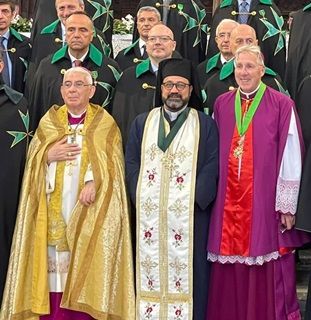
(The Right Reverend Bishop Kevin Francis Donlon, ECLJ, right in the photo)
God in his wisdom chooses the lowest of animal for Jesus to enter the fullness of his role not unlike the donkey that Mary rode on seeking to deliver Jesus in Bethlehem. It is interesting to note how the Evangelist describes this situation with the animal of lowly estate…”. The Lord has need for him”. The insignificant donkey and its colt performed the assigned role in carrying Christ both for his birth and for his death in the crucifixion. Neither would have been possible without the role of the donkey and the colt. This small image serves as a reminder that God takes the least for the work of his Kingdom. Little did the owners know that their act of submission and obedience to Jesus‘ need would bring about such a glorious event — the Triumphal Entry that is described in the verses.
As Palm Sunday marks the beginning of Holy Week and the journey of Jesus to Jerusalem, we must ask the question: How shall we journey this Week? Can we make the journey with humility? Can we walk in simplicity? Can we make the effort to transcend the hectic and, at times burdensome, aspects of life weighed down by things that are not what the soul’s journey is all about? Do we have the courage to not just cheer Jesus on with Hosannas but to walk every step with him? Let us renew our resolve this Palm Sunday to make the commitment of kenotic love and make the journey to Jerusalem with Our Lord.
Let Us Pray… All-powerful, eternal God, you have chosen to give mankind a model of humility; our Savior took on our flesh and subjected himself to the Cross. Grant us the grace to preserve faithfully the lessons he has given us in his Passion and to have a share in his resurrection. This we ask of you through our Lord Jesus Christ, your Son.
+ Kevin Francis Donlon, ECLJ,
Anglican Assistant Bishop of the Diocese of Zanzibar
UDALOSTI
- THE HOLY MEMORIAL OF SAN LAZZARO IN COVO 4. apríla 2025
- GIFT OF BOOKS ON THE ORDER TO THE LIBRARY OF THE PONTIFICAL THEOLOGICAL FACULTY OF SICILY 1. apríla 2025
- (bez názvu) 28. marca 2025
- REPORT 2024 DELL’OSPEDALIERE DEL GRAN BALIATO DI SICILIA 19. marca 2025
- Leprosy-Info April issue 19. marca 2025
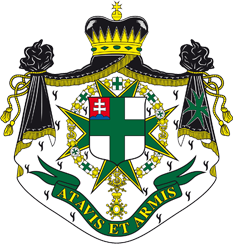
 Military and Hospitaller Order of St.Lazarus of Jerusalem Grand Priory Slovakia,
Military and Hospitaller Order of St.Lazarus of Jerusalem Grand Priory Slovakia,